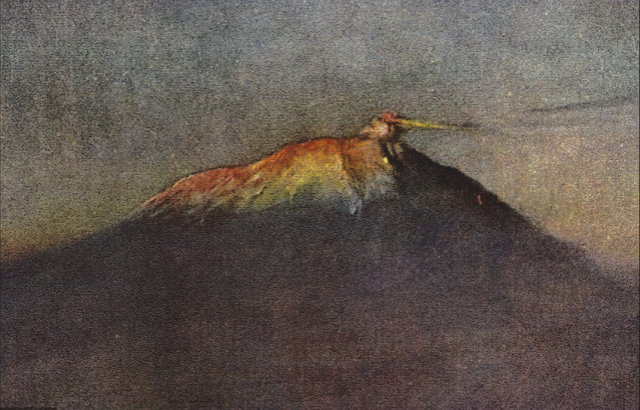ALFRED MAUDSLAY (1850-1931)
Volcán de Agua / Hunahpú (3,760 m- 12, 349 ft)
Guatemala
In Volcano de Agua from Santa Maria from the book A glimpse of Guatemala,
John Murray, ed. London, 1889
The volcano
Volcán de Agua (3, 760m - 12, 349 ft) (also known by Maya as Hunahpú meaning Place of flowers) is a stratovolcano located in the departments of Sacatepéquez and Escuintla in Guatemala.
The Spanish conquistadors also called it Hunapú until a lahar from the volcano on September 10, 1541 destroyed the original capital of Guatemala (now known as Ciudad Vieja) and the city was moved to the current site of Antigua Guatemala following this disaster.
Agua Volcano dominates the local landscape except when hidden by cloud cover. The volcano is within 5 to 10 km (3.1 to 6.2 mi) of the city of Antigua Guatemala and several other large towns situated on its northern apron. These towns have a combined population of nearly 100,000. It is within about 20 km of Escuintla (population, ca .100,000) to the south. Coffee is grown on the volcano's lower slopes.
In 1895 Anne Cary Maudslay and her husband, archeologist Alfred Percival Maudslay visited the Antigua Guatemala region as part of a journey through Guatemala's Maya and colonial archeological monuments, and climbed the Volcán de Agua (photo above) ; she wrote a book called A Glimpse at Guatemala where she explains that water from the volcano crater could not have destroyed the old Santiago.
The Volcán de Agua has been declared a protected area in 1956 and covers an area of 12,600 Ha.The photographer
The British diplomat, explorer and archaeologist Alfred Percival Maudslay was also a photographer... and rather a good one according to the numerous photographs on dry plate he left. He was one of the first Europeans to study Maya ruins.
After leaving Medical School, he moved to Trinidad, becoming private secretary to Governor William Cairns, and transferred with Cairns to Queensland. He subsequently moved to Fiji to work with Sir Arthur Gordon, its governor. Later he served as British consul in Tonga and Samoa. In February 1880, Maudslay resigned from the colonial service to pursue his own interests, having spent six years in the British Pacific colonies. He then joined his siblings in Calcutta during their round-the-world trip, returned to Britain in December, and then set out for Guatemala via British Honduras.
In Guatemala, Maudslay began the major archaeological work for which he is now best remembered. He started at the Maya ruins of Quirigua and Copan where, with the help of Frank Sarg, he hired labourers to help clear and survey the remaining structures and artefacts. Sarg also introduced Maudslay to the newly found ruins in Tikal and to a reliable guide Gorgonio López. Maudslay was the first to describe the site of Yaxchilán. With Teobert Maler, Alfred Maudslay explored Chichén in the 1880s and both spent several weeks at the site and took extensive photographs. Maudslay published the first long-form description of Chichen Itza in his book, "Biologia Centrali-Americana".
In the course of his surveys, Maudslay pioneered many of the later archaeological techniques. He hired Italian expert Lorenzo Giuntini and technicians to make plaster casts of the carvings, while Gorgonio López made casts of papier-mâché. Artist Annie Hunter drew impressions of the casts before they were shipped to museums in England and the United States. Maudslay also took numerous detailed photographs – dry plate photography was then a new technique – and made copies of the inscriptions.
All told, Maudslay made a total of six expeditions to Maya ruins. After 13 years of preparation, he published his findings in 1902 as a 5-volume compendium entitled Biologia Centrali-Americana, which contained numerous excellent drawings and photographs of Maya ruins, Maudslay's commentary, and an appendix on archaic calendars by Joseph Thompson Goodman.
In 1907 the Maudslays moved permanently back to Britain. Maudslay become a President of the Royal Anthropological Institute 1911–12. He also chaired the 18th International Congress of Americanists in London in 1912.
_______________________________
2018 - Wandering Vertexes...
by Francis Rousseau


















